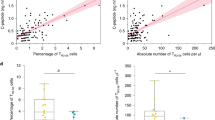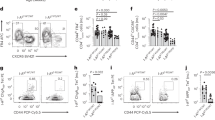Abstract
In autoimmune type 1 diabetes, pathogenic T lymphocytes are associated with the specific destruction of insulin-producing β-islet cells1,2. Identification of the autoantigens involved in triggering this process is a central question. Here we examined T cells from pancreatic draining lymph nodes, the site of islet-cell-specific self-antigen presentation3. We cloned single T cells in a non-biased manner from pancreatic draining lymph nodes of subjects with type 1 diabetes and from non-diabetic controls. A high degree of T-cell clonal expansion was observed in pancreatic lymph nodes from long-term diabetic patients but not from control subjects. The oligoclonally expanded T cells from diabetic subjects with DR4, a susceptibility allele for type 1 diabetes4, recognized the insulin A 1–15 epitope restricted by DR4. These results identify insulin-reactive, clonally expanded T cells from the site of autoinflammatory drainage in long-term type 1 diabetics, indicating that insulin may indeed be the target antigen causing autoimmune diabetes.
This is a preview of subscription content, access via your institution
Access options
Subscribe to this journal
Receive 51 print issues and online access
$199.00 per year
only $3.90 per issue
Buy this article
- Purchase on Springer Link
- Instant access to full article PDF
Prices may be subject to local taxes which are calculated during checkout


Similar content being viewed by others
References
Atkinson, M. A. & Maclaren, N. K. The pathogenesis of insulin-dependent diabetes mellitus. N. Engl. J. Med. 331, 1428–1436 (1994)
Eisenbarth, G. S. Type I diabetes mellitus: a chronic autoimmune disease. N. Engl. J. Med. 314, 1360–1368 (1986)
Hoglund, P. et al. Initiation of autoimmune diabetes by developmentally regulated presentation of islet cell antigens in the pancreatic lymph nodes. J. Exp. Med. 189, 331–339 (1999)
Thomson, G. et al. Genetic heterogeneity, modes of inheritance, and risk estimates for a joint study of Caucasians with insulin-dependent diabetes mellitus. Am. J. Hum. Genet. 43, 799–816 (1988)
Katz, J. D., Wang, B., Haskins, K., Benoist, C. & Mathis, D. Following a diabetogenic T cell from genesis through pathogenesis. Cell 74, 1089–1100 (1993)
Acha-Orbea, H. & McDevitt, H. O. The role of class II molecules in development of insulin-dependent diabetes mellitus in mice, rats and humans. Curr. Top. Microbiol. Immunol. 156, 103–119 (1990)
Haskins, K., Portas, M., Bergman, B., Lafferty, K. & Bradley, B. Pancreatic islet-specific T-cell clones from nonobese diabetic mice. Proc. Natl Acad. Sci. USA 86, 8000–8004 (1989)
Wegmann, D. R., Norbury-Glaser, M. & Daniel, D. Insulin-specific T cells are a predominant component of islet infiltrates in pre-diabetic NOD mice. Eur. J. Immunol. 24, 1853–1857 (1994)
Londei, M. et al. Persistence of collagen type II-specific T-cell clones in the synovial membrane of a patient with rheumatoid arthritis. Proc. Natl Acad. Sci. USA 86, 636–640 (1989)
Dayan, C. M. et al. Autoantigen recognition by thyroid-infiltrating T cells in Graves disease. Proc. Natl Acad. Sci. USA. 88, 7415–7419 (1991)
Hafler, D. A. et al. Oligoclonal T-lymphocytes in the cerebrospinal fluid of patients with inflammatory central nervous system diseases. J. Exp. Med. 167, 1625–1644 (1988)
Roep, B. O. T-cell responses to autoantigens in IDDM. Diabetes 45, 1147–1156 (1996)
Wong, F. S. et al. Identification of an MHC class I-restricted autoantigen in type 1 diabetes by screening an organ-specific cDNA library. Nature Med. 5, 1026–1031 (1999)
Todd, J. A., Bell, J. I. & McDevitt, H. O. HLA antigens and insulin-dependent diabetes. Nature 333, 710 (1988)
Schloot, N. C. et al. Comparison of cytokine ELISpot assay formats for the detection of islet antigen autoreactive T cells. Report of the third immunology of diabetes society T-cell workshop. J. Autoimmun. 21, 365–376 (2003)
Peakman, M. et al. Characterization of preparations of GAD65, proinsulin, and the islet tyrosine phosphatase IA-2 for use in detection of autoreactive T-cells in type 1 diabetes: report of phase II of the Second International Immunology of Diabetes Society Workshop for Standardization of T-cell assays in type 1 diabetes. Diabetes 50, 1749–1754 (2001)
Eisenbarth, G. S. et al. Insulin autoimmunity: prediction/precipitation/prevention type 1A diabetes. Autoimmun. Rev. 1, 139–145 (2002)
Harrison, L. C. et al. Islet-reactive T cells are a marker of preclinical insulin-dependent diabetes. J. Clin. Invest. 89, 1161–1165 (1992)
Astill, T. P., Ellis, R. J., Arif, S., Tree, T. I. M. & Peakman, M. Promiscuous binding of proinsulin peptides to Type 1 diabetes-permissive and- protective HLA class II molecules. Diabetologia 46, 496–503 (2003)
Endl, J. et al. Identification of naturally processed T cell epitopes from glutamic acid decarboxylase presented in the context of HLA-DR alleles by T lymphocytes of recent onset IDDM patients. J. Clin. Invest. 15, 2405–2415 (1997)
Mycko, M. P. et al. Cross-reactive TCR responses to self antigens presented by different MHC class II molecules. J. Immunol. 173, 1689–1698 (2004)
Tian, J., Lehmann, P. & Kaufman, D. Determinant spreading of T helper cell 2 (Th2) responses to pancreatic islet autoantigens. J. Exp. Med. 186, 2039–2043 (1997)
Nakano, N., Kikutani, H., Nishimoto, H. & Kishimoto, T. T cell receptor V gene usage of islet β cell-reactive T cells is not restricted in non-obese diabetic mice. J. Exp. Med. 173, 1091–1097 (1991)
Miyazaki, A. et al. Predominance of T lymphocytes in pancreatic islets and spleen of pre-diabetic non-obese diabetic (NOD) mice: a longitudinal study. Clin. Exp. Immunol. 60, 622–630 (1985)
Candeias, S., Katz, J., Benoist, C., Mathis, D. & Haskins, K. Islet-specific T-cell clones from nonobese diabetic mice express heterogeneous T-cell receptors. Proc. Natl Acad. Sci. USA 88, 6167–6170 (1991)
Baker, F., Lee, M., Chien, Y.-h. & Davis, M. Restricted islet-cell reactive T cell repetoire of early pancreatic islet infiltrates in NOD mice. Proc. Natl Acad. Sci. USA 99, 9374–9379 (2002)
Sibley, R. K., Sutherland, D. E., Goetz, F. & Michael, A. F. Recurrent diabetes mellitus in the pancreas iso- and allograft. A light and electron microscopic and immunohistochemical analysis of four cases. Lab. Invest. 53, 132–144 (1985)
Jaeckel, E., Lipes, M. A. & von Boehmer, H. Recessive tolerance to preproinsulin 2 reduces but does not abolish type 1 diabetes. Nature Immunol. 5, 1028–1035 (2004)
Nakayama, M. et al. Prime role for an insulin epitope in the development of type 1 diabetes in NOD mice. Nature doi:10.1038/nature03523 (this issue)
Yoon, J. W. et al. Control of autoimmune diabetes in NOD mice by GAD expression or suppression in beta cells. Science 284, 1183–1187 (1999)
Han, M. et al. Invariant or highly conserved TCR α are expressed on double-negative (CD3+CD4-CD8-) and CD8+ T cells. J. Immunol. 163, 301–311 (1999)
Akatsuka, Y., Martin, E., Madonik, A., Barsoukov, A. & Hansen, J. Rapid screening of T-cell receptor (TCR) variable gene usage by multiplex PCR: application for assessment of clonal composition. Tissue Antigens 53, 122–134 (1999)
Acknowledgements
We thank V. Kuchroo and G. Fathman for critical reading of the manuscript. We thank G. Nepom for B cell lines, and R. Neal Smith and N. Kirchhof for expert immunohistochemical and histological tissue staining. These studies were supported by grants to D.A.H. (NIH), to Y.C. (JDRFI Fellowship), to L.B. (NMSS Fellowship) and to S.C.K. (Boston Area Diabetes Endocrinology Research Center). D.A.H. is a recipient of the NIH Javits Investigator Award.
Author information
Authors and Affiliations
Corresponding author
Ethics declarations
Competing interests
The authors declare that they have no competing financial interests.
Supplementary information
Supplementary Figure S1
Histological examination of pancreas and lymphocytic infiltrate in islets from diabetic subject 3. (PDF 896 kb)
Supplementary Figure S2
Histological examination of pancreas from a long term diabetes subject (2). (PDF 1277 kb)
Supplementary Tables S1, S2, and S3
Supplementary Table S1: oligoclonal Vβ Chain Usage of T-cell clones isolated from subjects with Type 1 diabetes. Supplementary Table S2: oligoclonal Vα Sequences of T-cell clones expressing identical Vβ chains from diabetic pancreatic draining lymph nodes. Supplementary Table S3: TCR Vβ from PLN-derived insulin-reactive Ba.14 T-cell clone is not detected in diabetic subject 2 (Ba) spleen. (PDF 118 kb)
Rights and permissions
About this article
Cite this article
Kent, S., Chen, Y., Bregoli, L. et al. Expanded T cells from pancreatic lymph nodes of type 1 diabetic subjects recognize an insulin epitope. Nature 435, 224–228 (2005). https://doi.org/10.1038/nature03625
Received:
Accepted:
Issue Date:
DOI: https://doi.org/10.1038/nature03625
This article is cited by
-
Pancreatic draining lymph nodes (PLNs) serve as a pathogenic hub contributing to the development of type 1 diabetes
Cell & Bioscience (2023)
-
A mutant α1antitrypsin in complex with heat shock proteins as the primary antigen in type 1 diabetes in silico investigation
Scientific Reports (2021)
-
Loss of MafA and MafB expression promotes islet inflammation
Scientific Reports (2019)
-
Transgenic substitution with Greater Amberjack Seriola dumerili fish insulin 2 in NOD mice reduces beta cell immunogenicity
Scientific Reports (2019)
-
What the HLA-I!—Classical and Non-classical HLA Class I and Their Potential Roles in Type 1 Diabetes
Current Diabetes Reports (2019)
Comments
By submitting a comment you agree to abide by our Terms and Community Guidelines. If you find something abusive or that does not comply with our terms or guidelines please flag it as inappropriate.



